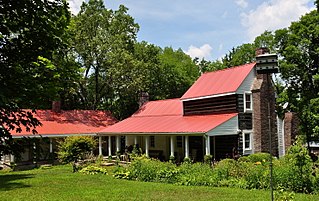
The Alexander McMillan House is a historic home located at 7703 Strawberry Plains Pike in Knox County, Tennessee, United States. It was constructed in 1785 by Alexander McMillan (1749–1837), an early Knox County pioneer.
This is a list of the National Register of Historic Places listings in Knox County, Tennessee.

Rigbie House, also known as "Phillip's Purchase", is a historic home located at Berkley, Harford County, Maryland. It is a 1 1⁄2-story, frame and stone structure built about 1781. It was one of a series of forest outposts fortified against the Indians and representing Lord Baltimore’s claim of 1632 to land extending north to the 40th parallel. In April 1781, it was the place where the Marquis de Lafayette’s officers quelled a mutiny that might have prevented his army of New England troops, who had been headed homeward, from turning south again to join General Greene and General Washington at Yorktown, in which case that battle might never have been fought.

The Waggoner Mansion is a historic mansion in Decatur, Texas. The sixteen room mansion was built in 1883 by the Waggoner Family. It was purchased in 1942 by Mr. and Mrs. Phil Luker.

The Drouillard House is a historic house at Cumberland Furnace, Tennessee. Built in 1868-1870 in the vicinity of Cumberland Furnace, the three-story house was a summer residence for Nashville socialite Mary Florence Kirkman and her husband Captain James Pierre Drouillard. It has been listed on the National Register of Historic Places since December 27, 1977.

Oakslea Place is a historic mansion in Jackson, Tennessee, USA. Built circa 1860, prior to the American Civil War, it was expanded in 1900.

Beech Grove is a historic mansion in Nashville, Tennessee, USA. Built as a log house circa 1850, it was a Southern plantation with African slaves in the Antebellum era. In the 1910s, it became a livestock farm.

Belle Vue II is a historic mansion in Bellevue, a suburb of Nashville, Tennessee, USA. It was a Southern plantation worked by enslaved African Americans prior to the American Civil War of 1861-1865. After the war, it remained in the same family until the 1970s.

The McGavock-Gatewood-Webb House, also known as Blue Fountain, is a historic house in Nashville, Tennessee, USA. It was built in the 1840s.

The Smith Farmhouse is a historic house in Pasquo, Tennessee, USA.

The Frederick Stump Tavern-Inn is a historic house in Nashville, Tennessee, USA. It was built by Colonel Frederick Stump, an early settler of Nashville who arrived in the region as part of the first group of white settlers at Fort Nashboro in 1779. It has been listed on the National Register of Historic Places since April 2, 1973.
Devon Farm is a historic farm in Nashville, Tennessee, USA. It has been listed on the National Register of Historic Places since August 28, 1974.

Ashcrest Farm is a historic mansion in Hendersonville, Tennessee, U.S.. Designed in the Classical Revival architectural style, it was built by slaves before the American Civil War and black laborers after the war. The land has been owned by the same family since 1810. Today, it is a horse farm.

The Lairdland Farm House is a historic farmhouse in Giles County, Tennessee, U.S..

The Benjamine Rucker House is a historic mansion in Rutherford County, Tennessee, U.S..

The Benajah Gray Log House is a historic loghouse in Antioch, Tennessee, U.S..

The Hows-Madden House is a historic mansion in Nashville, Tennessee, U.S.. It was built in 1830 for Rasa Hows, a settler and slaveholder. After he died in 1858, it was inherited by his widow and his sons, including Stephen Hows, who served under Nathan Bedford Forrest in the Confederate States Army during the American Civil War of 1861–1865. It has been listed on the National Register of Historic Places since November 23, 1984.

The Prewitt-Amis-Finney House, also known as Turnhill Farm, is a historic three-story house in Culleoka, Tennessee, U.S.. Built for the slaveholding Prewett family in 1810, it was established as a mule farm. It is located a few miles away from Columbia, and it overlooks Fountain Creek.

The Maple Dean Farm is a historic farmhouse in Shelbyville, Tennessee, U.S.. Built in 1886 on a farm established in 1819, it was designed in the Eastlake architectural style. It became a century farm in 1976, and it was listed on the National Register of Historic Places in 1976.
Ewing Farm is a historic farmhouse three miles away from Lewisburg, Tennessee, US.













